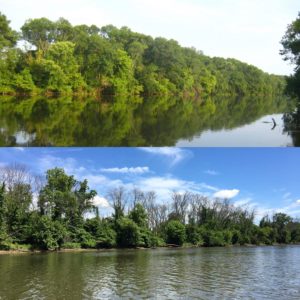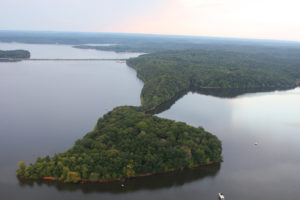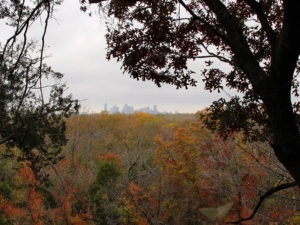Seeing the devastation caused recently by hurricanes and wild fires in both the United States mainland and the Caribbean islands made me think about our native woodlands and the organizations dedicated to preserving and maintaining them. Here are three sterling examples from around the nation, all of which helped me feel hopeful at a time when the forces of destruction seem to be getting an upper hand.

Riparian forests on Maryland’s Anacostia River in the summer of 2011 (top) and in the summer of 2017 (bottom), showing the devastating effects of emerald ash borer. Photograph by Anacostia Watershed Society
Heavy pollution of the Anacostia River, which flows from Prince George’s County in Maryland into Washington, D.C., where it empties into the Potomac, has led to many public and private organizations, businesses, and agencies to join in efforts to protect the ecologically valuable waterway. One such is the 25-year-old Anacostia Watershed Society, which has recently focused its attention on the devastation that the invasive emerald ash borer is causing the Anacostia’s riparian forests where ash trees abound. Concentrating on a particularly hard-hit two-acre section of Bladensburg Waterfront Park, this spring the Society and volunteers from the World Bank planted 100 native trees to replace the dead ash trees. The new stock comprises nine-borer resistant hardwood species, including swamp white oak, sweetbay magnolia, river birch, black willow, pawpaw, and others. Thanks to these efforts, some stretches of the Anacostia riverbank won’t look so leafless and forlorn in summers to come.

Amy Weingartner Branigin Peninsula Preserve, managed by the Sycamore Land Trust, in Lake Monroe, Bloomington, Indiana. Photograph by John Lawrence
Founded in 1990, the Sycamore Land Trust is a nonprofit organization that seeks to preserve the disappearing natural and agricultural landscape of southern Indiana through direct ownership or by holding conservation easements on privately held land. As of January 2017, it has protected 100 properties totaling more than 9,000 acres. One recent acquisition is the Amy Weingartner Branigin Peninsula Preserve, 48 acres of thick upland hardwood forest extending into the middle of Lake Monroe, an important habitat for red-shouldered hawks, broad-winged hawks, and eastern box turtles. By connecting to the Brown County Hills forest, the new preserve adds to the largest contiguous forest block in the state. Utilizing an old road running down the peninsula, the Hoosier Hikers Council has built a 2.2-mile-long trail flanked by sycamores, yellow poplars, sugar maples, red and white oaks, and other varieties of American hardwood trees. I can’t wait to visit.

The downtown Dallas skyline rises behind the expanse of Great Trinity Forest, the largest urban hardwood preserve in America. Photograph by Chris Jackson
Not all forest conservation takes place in the wilderness. The Great Trinity Forest in Dallas comprises 6,000 acres of preserved old growth woodlands that the city claims is the largest urban hardwood bottomland forest in America. An 11-mile-long stretch of land along the Trinity River, the preserve certainly dwarfs New York’s 840-acre Central Park, although its massive size means its remoter areas are sometimes used for dumping, poaching, and other illegal activities. The city, working with state and federal agencies, is committed to conserving and restoring the forest. Several trails already exist or are currently being built by organizations like Groundwork Dallas, enabling the public to hike among the oaks, elms, buckeyes, cottonwoods, and other indigenous hardwoods that populate the forest, which is also home to deer, otters, and an extraordinary diversity of birds, including blue herons, wood storks, ibises, and red-shouldered hawks. All within sight of the city’s bustling downtown!
Anacostia Watershed Society
4302 Baltimore Avenue
Bladensburg, MD 20710
www.anacostiaws.org
Sycamore Land Trust
4898 East Heritage Woods Rd
Bloomington, IN 47401
sycamorelandtrust.org
Great Trinity Forest
Gateway and Horse Trail
2161 Dowdy Ferry Road
Dallas, TX 75201
www.dallasparks.org



